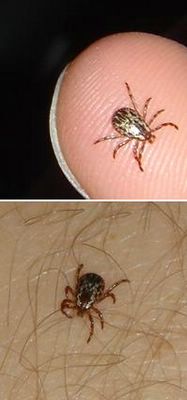Arachnid Friday: The Blood Suckers

Most of you science types, when you are on your toes, will correctly refer to ticks and mites as arachnids instead of insects. I have seen a few people slip up lately though so I thought I would post my only tick pics to make this point and to provide a little medical info. I believe this is a Wood Tick which includes the American Dog Ticks and is in the family of hard ticks known as Ixodidae. The other family is Argasidae, or soft ticks. There are many important diseases that are spread by ticks. From my medical microbiology text, here is a list of the diseases followed by their etiologic agents.
Rocky Mountain Spotted Fever--------Rickettsia rickettsii
Tularemia--------Francisella tularensis
Lyme disease--------Borrelia burgdorferi
Ehrlichiosis--------Ehrlichia species
Q fever--------Coxiella burnetii
Colorado tick fever--------Orbivirus
Relapsing fever--------Borrelia species
Babesiosis--------Babesia microti
Tick paralysis--------Neurotoxins from tick saliva
Luckily most of these diseases can be effectively treated with doxycycline. The exceptions are Tularemia for which streptomycin is effective, Colorado tick fever which is a viral illness and requires supportive care, Tick paralysis which improves with removal of the tick along with any retained mouthparts, and babesiosis which requires a combination of drugs geared toward protozoans.
My personal experience with tick bites has changed since my arrival to the world of private practice.
In residency most commonly it went like this: You have a very sick patient in the hospital whom you have been working on for several days, and is not getting better or is declining. Amid all the head scratching and pimping someone remembers the possibility of tick-borne illnesses which can have a large range of systemic manifestations. Someone goes back and asks about a history of tick exposure, and at that point even if the only clue is that their grandmother was bitten 4 weeks earlier, you are going for it and ordering an extensive serologic work up (aka tick titers). Then the results usually turn up negative a week later, after you have begun empiric antibiotic coverage and the patient is dead, better, or at a larger instituion.
The new scenario for me is someone comes to clinic after having been bitten by a tick or having seen a tick and may have had a local reaction to the bite but no other symptoms and they are worried about Lyme disease. Then we have to talk about the risk/benefit of using prophylactic antibiotic therapy which is generally not recommended except possibly in areas where it is endemic. Sometimes I have someone who has a tick exposure along with some systemic symptoms such as fever or rash. Usually I give them a prescription for doxycycline and close follow-up.
My pics are not that great, but here are some great tick glamour shots from Artsy Science.
Now for the obvious but necessary defensive statement: Remember, this is only for fun and should not replace a visit to a physician if you are ill. Also note that doxycycline is usually not recommended for children.
Don’t forget to check out Modulator’s Friday Ark.
Labels: Friday Ark, photography, zoology










2 Comments:
Consider me duly chastised. Having a micron view of the world is no excuse for screwing up the taxonomy of larger animals.
I wasn't trying to call you out specifically, but since you mentioned it, your post was the instigator of this one. That plus the fact that I didn't really have any other good animal pics for the Ark at the time.
Post a Comment
<< Home